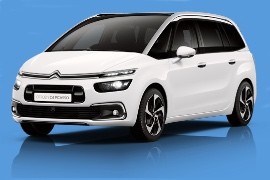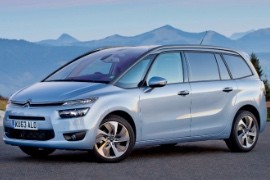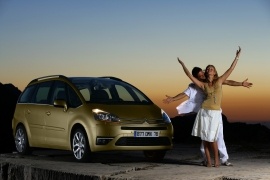CITROEN Grand C4 Picasso Models/Series Timeline, Specifications & Photos
First production year: 2006
Engines: Gasoline, Diesel
Body style: Van
Reaching its 2nd generation in 2016, the Grand C4 Picasso was unveiled for the first time in 2014.
A highly practical and versatile compact MPV, the C4 Picasso had strong competitors, however, some of its features highly differentiated it from the others: the MPV almost floated over the road imperfections, the commanding driving position was excellent and the panoramic windshield provided high visibility.
For 2016, the compact SUV became more efficient, more sophisticated, offered great space, safety and even cost effectiveness.
With a variety of engine choices, the C4 Picasso suited the most picky buyers.
A downsized 1.2-liter 3-cylinder Puretech turbo unit that developed 130 hp was more adequate for low mileage, while people looking for a more agile unit could choose between a 1.6-liter liter with 100 or 120 hp, respectively the most powerful available with the top-of-the-range, a 2.0-liter.
Slight updates were brought to the exterior design, such as the smaller lower grille and the extra chrome trim across the daytime running lights.
Behind the wheel, the dashboard was dominated by twin screen, the 12-inch panoramic HD panel replacing the normal set fo the conventional cluster gauges.
Greatly suitable for larger families, the C4 Picasso offered a proper seating arrangement with 3 separate chairs in the back. As there was no central transmission tunnel, 3 adults could comfortably sit in the 2nd row. The 3rd row of seats was designed for kids, as adults would have little legroom and headroom available.
Citroen introduced the second generation of the C4 Picasso in 2013 along with its bigger brother, the C4 Grand Picasso.
While other carmakers were more concerned about SUVs, the French carmaker believed that the minivans didn't have their last saying. With respectable experience in building them, it used the same EMP2 platform to offer a true family carrier, with up to seven seats and big interior modularity.
The C4 Grand Picasso featured the same front fascia as the C4 Picasso. Citroen's designers made a gap between the hood and the front bumper where they installed two chromed slats and the “double-chevron” badge in the middle. On the outer sides, they squeezed the LED daytime running lights and the turn signals in the same strip. The bumper sported both the headlights at its upper side and the fog lights in the apron. From its sides, the C4 Grand Picasso had a long rear window between the rear doors and the tailgate. In the back, the up-mounted taillights flanked the tailgate.
Inside, the carmaker installed a digital instrument panel in the middle of the dashboard. On the front side of the dash panel, Citroen mounted the infotainment screen, between the front passengers. One of the greatest advantages of the C4 Grand Picasso was the seven-seat options in a 2-3-2 layout. In the middle row, the carmaker installed individual seats, which could slide, tilt and fold. They also sported Isofix child-seat anchor points. The last two seats in the trunk area were cramped.
Citroen offered the C4 Grand Picasso a choice of three gasoline and four turbo-diesel engines. They were paired to either a five-speed manual or a six-speed manual, with an option for an automated gearbox for selected engines. The carmaker was known for its comfortable vehicles and prepared an air suspension for the Grand Picasso's rear axle.
Designed to replace the already dated Citroen XSara Picasso, the new Grand C4 Picasso shared its platform with the regular C4 Picasso.
More practical than the C4 Picasso, the Grand version of it offered seating for 7 occupants, thus it was most appreciated by mid to large families.
While the 3rd row of seats was only suitable for children, all the other occupants enjoyed a roomy cabin with great leg room and head room.
With all seats up, the cargo area was limited, with space for few light bags. However, both the 3rd and the 2nd row seats folded flat, transforming the practical MPV into a van.
However, the upmarket feeling given by the front cabin was far from a van’s. The quality of materials was good and everything looked well put together.
Lots of storage spaces were available inside, including room for a bag between the 2 front seats, as the Citroen Grand C4 Picasso was equipped with an electronic parking brake.
Offering an airy feeling and high visibility with the panoramic windscreen, the cabin was also well insulated, thus turned the MPV into a quiet and refined cruiser. Moreover, an optional pneumatic rear suspension was available with most engine choices.
Not the most pleasant to drive on twisty roads, the Grand Picasso leaned in corners.


